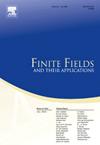非二进制LCD二次残码和双二次残码的构造
IF 1.2
3区 数学
Q1 MATHEMATICS
引用次数: 0
摘要
线性互补对偶码(LCD)是一类重要的纠错码,在密码学和秘密共享[1]、[4]、[7]等领域有着广泛的应用。本文从非二进制二次残差码(QR码)和非二进制双QR码出发,构造了一大类非二进制LCD码。我们还介绍了一类扩展拟二次剩余码(QQR),并利用这些码构造了自正交码。作为我们研究的一个应用,我们提出了参数的最优三元自正交码[24,6,12]。我们还构造了参数为[2(q+1),q+12,2d]p的自正交码的例子,以及参数为[2q,q−12,2d]p和[2q,q+12,2d]p / Fp的LCD码的例子,用于不同素数p和q的值。本文章由计算机程序翻译,如有差异,请以英文原文为准。
On the construction of nonbinary LCD quadratic residue and double quadratic residue codes
Linear complementary dual (LCD) codes are an important class of error-correcting codes because of their applications in many areas such as their applications in cryptography and secret sharing [1], [4], [7]. In this paper, we construct a large class of nonbinary LCD codes from the class of nonbinary quadratic residue (QR) codes and nonbinary double QR codes. We have also introduced the class of extended quasi quadratic residue (QQR) codes and construct self-orthogonal codes from these codes. As an application of our study, we have presented an optimal ternary self-orthogonal code of parameters . We have also constructed examples of self-orthogonal codes with parameters and also examples of LCD codes with parameters and over for different values of primes p and q.
求助全文
通过发布文献求助,成功后即可免费获取论文全文。
去求助
来源期刊
CiteScore
2.00
自引率
20.00%
发文量
133
审稿时长
6-12 weeks
期刊介绍:
Finite Fields and Their Applications is a peer-reviewed technical journal publishing papers in finite field theory as well as in applications of finite fields. As a result of applications in a wide variety of areas, finite fields are increasingly important in several areas of mathematics, including linear and abstract algebra, number theory and algebraic geometry, as well as in computer science, statistics, information theory, and engineering.
For cohesion, and because so many applications rely on various theoretical properties of finite fields, it is essential that there be a core of high-quality papers on theoretical aspects. In addition, since much of the vitality of the area comes from computational problems, the journal publishes papers on computational aspects of finite fields as well as on algorithms and complexity of finite field-related methods.
The journal also publishes papers in various applications including, but not limited to, algebraic coding theory, cryptology, combinatorial design theory, pseudorandom number generation, and linear recurring sequences. There are other areas of application to be included, but the important point is that finite fields play a nontrivial role in the theory, application, or algorithm.

 求助内容:
求助内容: 应助结果提醒方式:
应助结果提醒方式:


